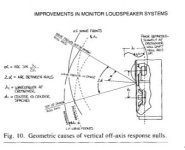Is there someone who can explain this further and even have experience:
https://lyngdorf.steinwaylyngdorf.com/lyngdorf-ls-1000/
I can see that the tweeter is slightly angeled. But Lyngdorf say this:
The Lyngdorf LS-1000 Left has a sound dispersion slightly beaming inwards when placed on the left side, away from the side wall and towards the listening area.
The Lyngdorf LS-1000 Right has a sound dispersion slightly beaming inwards when placed on the right side, away from the side wall and towards the listening area.
I have been explained that f ex JBL 4435 have this feature for high placement in studios.
I ask because i am interested to make a similar inwall line source whitout physical toe-in


https://lyngdorf.steinwaylyngdorf.com/lyngdorf-ls-1000/
I can see that the tweeter is slightly angeled. But Lyngdorf say this:
The Lyngdorf LS-1000 Left has a sound dispersion slightly beaming inwards when placed on the left side, away from the side wall and towards the listening area.
The Lyngdorf LS-1000 Right has a sound dispersion slightly beaming inwards when placed on the right side, away from the side wall and towards the listening area.
I have been explained that f ex JBL 4435 have this feature for high placement in studios.
I ask because i am interested to make a similar inwall line source whitout physical toe-in
Dispersion will tend more toward the nearer side of the baffle than the farther side, although it may be somewhat frequency dependent since it relies on diffraction around the edges.
I would wonder how much toe-in there is and what distance it is optimized for. I would try toe-in regardless of what's stated, it doesn't hurt to try especially with room acoustics and distance in play.
Rob 🙂
Rob 🙂
This may also be about the orientation of the primary directivity lobe in the crossover region. That can be designed into the crossover.
But how do i make this crossover?
3 order acoustical i think
And then make an overlap / sum with an error who move the main peaking axis sideways?
3 order acoustical i think
And then make an overlap / sum with an error who move the main peaking axis sideways?
Yes.. except don't call it an error because it isn't wrong to tilt the lobe away from the listening position. The answer is not something we can guess, you'll have to measure and work it out.nd then make an overlap / sum with an error who move the main peaking axis sideways?
Is it possible to achieve the same result with an ordinary two way speaker turned 90 degrees? With the woofer and tweeter on s horisontal line?
Will the trade off with horisontal dips outside the sweet spot be problemattic?
Is it any successful speakers who have landscape orientation?
Will the trade off with horisontal dips outside the sweet spot be problemattic?
Is it any successful speakers who have landscape orientation?
- Home
- Loudspeakers
- Multi-Way
- Toe-in with passive crossover and not placement?
